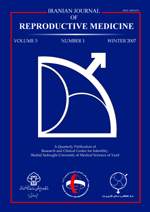
|
International Journal of Reproductive BioMedicine
Research and Clinical Center for Infertility, Shahid Sadoughi University of Medical Sciences of Yazd
ISSN: 1680-6433
EISSN: 1680-6433
Vol. 15, No. 4, 2017, pp. 225-330
|
 Bioline Code: rm17030
Bioline Code: rm17030
Full paper language: English
Document type: Research Article
Document available free of charge
|
|
|
International Journal of Reproductive BioMedicine, Vol. 15, No. 4, 2017, pp. 225-330
| en |
Accuracy of color Doppler ultrasonography and magnetic resonance imaging in diagnosis of placenta accreta: A survey of 82 cases
Ayati, Sedigheh; Pourali, Leila; Pezeshkirad, Masoud; Toosi, Farokh Seilanian; Nekooei, Sirous; Shakeri, Mohammad Taghi & Golmohammadi, Mansoureh Sadat
Abstract
Background: Placenta adhesive disorder (PAD) is one of the most common causes of postpartum hemorrhage and peripartum hysterectomy. The main risk factors are placenta previa and prior uterine surgery such as cesarean section. Diagnosis of placenta adhesive disorders can lead to a decrease of maternal mortality and morbidities.
Objective: The purpose of this study was to compare the accuracy of color Doppler ultrasonography and magnetic resonance imaging (MRI) in the diagnosis of PADs.
Materials and Methods: In this is cross-sectional study, Eighty-two pregnant women who were high risk for PAD underwent color Doppler ultrasound and MRI after 18 weeks of gestation. The sonographic and MRI findings were compared with the final pathologic or clinical findings. P<0.05 was considered statistically significant.
Results: Mean maternal age was 31.42±4.2 years. The average gravidity was third pregnancy. 46% of patients had placenta previa. The history of the previous cesarean section was seen in 79 cases (96%). The diagnosis of placenta adhesive disorder was found in 17 cases (21%). Doppler sonography sensitivity was 87% and MRI sensitivity was 76% (p=0.37). Doppler sonography specificity was 63% and MRI specificity was 83% (p=0.01).
Conclusion: Women with high-risk factors for PAD should undergo Doppler ultrasonography at first. When results on Doppler sonography are equivocal for PAD, MRI can be performed due to its high specificity.
Keywords
Placenta previa; Color Doppler ultrasonography; Magnetic resonance imaging
|
| |
© Copyright 2017 - Iranian Journal of Reproductive Medicine
Alternative site location: http://www.ijrm.ir
|
|
